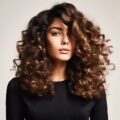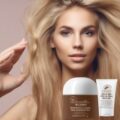Introduction to Hair Frizz
Hair frizz is a common concern that many people face, regardless of hair type or texture. Understanding the different types of frizz and their causes can help us approach our hair care with more compassion and self-acceptance. This article will explore various frizz types, their underlying causes, and gentle ways to manage them while embracing our natural hair texture.
What Causes Frizz?
Before diving into specific types of frizz, it’s important to understand the general causes. Frizz occurs when the hair’s cuticle layer is raised, allowing moisture to enter the hair shaft, causing it to swell and appear frizzy. Some common causes include:
- Humidity in the environment
- Dry or damaged hair
- Overwashing or using harsh products
- Heat styling
- Genetic factors
Remember, some level of frizz is natural and can add character to your hair. Embracing your hair’s unique texture is an important part of self-love and acceptance.
Types of Frizz and Gentle Management Techniques
1. Surface Frizz
Surface frizz appears as flyaways on the outer layer of your hair. It’s often caused by dryness or damage. To manage surface frizz gently:
- Use a leave-in conditioner to add moisture
- Apply a small amount of hair oil to the ends
- Try a silk pillowcase to reduce friction while sleeping
2. Halo Frizz
Halo frizz forms a ring of frizzy hair around the crown of your head. It’s common in curly and wavy hair types. To care for halo frizz:
- Use a microfiber towel to gently dry your hair
- Apply styling products to damp hair
- Consider “plopping” your hair to enhance natural curl patterns
3. In-The-Curl Frizz
This type of frizz occurs within curly hair patterns, disrupting the curl definition. To nurture curls and reduce in-the-curl frizz:
- Use a sulfate-free shampoo to avoid stripping natural oils
- Deep condition regularly
- Apply styling products using the “praying hands” method
Embracing Your Natural Texture
While managing frizz can be part of a hair care routine, it’s equally important to embrace your hair’s natural texture. Here are some ways to cultivate a positive relationship with your hair:
- Experiment with different hairstyles that work with your natural texture
- Use products that enhance rather than fight against your hair type
- Practice positive self-talk about your hair
- Find inspiration from others who celebrate similar hair textures
Remember, your hair is a part of what makes you unique. Embracing its natural state can be a powerful act of self-love and acceptance.
Nourishing Hair Care Practices
Regardless of your hair type or the kind of frizz you experience, certain nourishing practices can benefit all hair types:
- Stay hydrated by drinking plenty of water
- Eat a balanced diet rich in vitamins and minerals
- Limit heat styling and always use a heat protectant when you do
- Get regular trims to prevent split ends
- Use a satin or silk bonnet at night to protect your hair
These practices not only help manage frizz but also promote overall hair health, allowing your natural beauty to shine through.
FAQ: Understanding and Embracing Frizzy Hair
Q1: Is frizzy hair unhealthy?
A1: Not necessarily. Frizz is often a natural characteristic of certain hair types, especially curly and wavy hair. While excessive frizz can sometimes indicate dryness or damage, some level of frizz is completely normal and doesn’t mean your hair is unhealthy.
Q2: Can I permanently get rid of frizz?
A2: While you can manage frizz, it’s not always possible or desirable to eliminate it completely. Instead of trying to “get rid” of frizz, focus on nourishing your hair and embracing its natural texture. Remember, frizz can add volume and character to your hair.
Q3: How often should I wash frizzy hair?
A3: The frequency of washing depends on your hair type and lifestyle. Generally, washing less frequently (2-3 times a week) can help retain natural oils that keep frizz at bay. However, listen to your hair’s needs and adjust accordingly.
Q4: Are there any natural remedies for frizzy hair?
A4: Yes, many natural ingredients can help manage frizz. Some options include coconut oil, aloe vera, and apple cider vinegar rinses. However, remember that what works for one person may not work for another. It’s about finding what your hair responds to best.
Q5: How can I learn to love my frizzy hair?
A5: Learning to love your hair is a journey of self-acceptance. Start by focusing on your hair’s positive qualities, experimenting with styles that work with your natural texture, and surrounding yourself with positive influences who celebrate diverse hair types. Remember, your frizz is part of what makes you unique and beautiful.
Conclusion: Celebrating Your Unique Hair
Understanding different types of frizz is just the beginning of a journey towards hair acceptance and self-love. While it’s okay to want to manage frizz, it’s equally important to appreciate the uniqueness of your hair texture. Whether you have surface frizz, halo frizz, or in-the-curl frizz, remember that your hair is a beautiful part of who you are.
By adopting gentle hair care practices, nourishing your hair from the inside out, and cultivating a positive attitude towards your natural texture, you can develop a loving relationship with your hair. Embrace the frizz, celebrate your unique beauty, and let your authentic self shine through. After all, true beauty comes from self-acceptance and the confidence to be unapologetically you.









